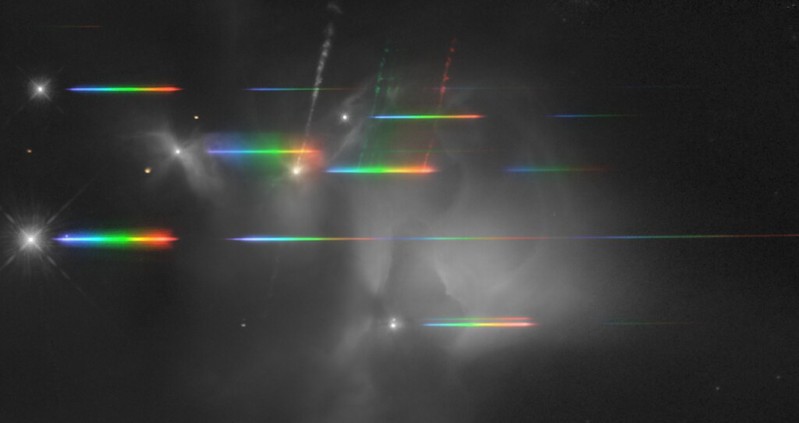Emission and absorption spectra are both unique tools used to examine the composition of atoms and elements. Emission spectra involve examining light that is emitted from molecules or atoms when energy is added, while Absorption Spectra involves looking at how light interacts with molecules or atoms when energy is removed.
What is an emission spectrum?
(Photo By Judy Schmidt on Flickr)

An emission spectrum is a type of spectrum that results from the emission of light by atoms or molecules. The intensity of the light at each wavelength is proportional to the number of atoms or molecules emitting at that wavelength. The emission spectrum of a particular element or molecule can be used as a fingerprint to identify it.
The word “emission” comes from the Latin word for “to send out”. An emission spectrum is sometimes also called an atomic emission spectrum or a molecular emission spectrum.
What is an absorption spectrum?
An absorption spectrum is a spectrum in which there are one or more dark lines or bands. These dark lines correspond to the absorption of light at certain wavelengths by the atoms or molecules of the material through which the light passes. The strength of the absorption depends on the amount of material, the type of atoms or molecules, and the wavelength of the light.
The difference between emission and absorption spectra
Emission spectra and absorption spectra are two types of atomic spectra. Emission spectra occur when an atom emits light, while absorption spectra occur when an atom absorbs light. The main difference between emission and absorption spectra is that emission spectra are always continuous, while absorption spectra can be either continuous or discrete.
When an atom emits light, it does so at certain wavelengths. These wavelengths correspond to the energy levels of the atom’s electrons. The higher the energy level of the electron, the shorter the wavelength of light that it will emit. The emission spectrum of an atom is a plot of the intensities of all the different wavelengths of light that it emits.
An absorption spectrum occurs when an atom absorbs light instead of emitting it. Absorption spectra are also determined by the energy levels of an atom’s electrons. When an electron absorbs a photon, its energy level increases by an amount equal to the photon’s energy. The lower the energy level of the electron, the more likely it is to absorb a photon. As with emission spectra, the absorption spectrum of an atom is a plot of the intensities of all the different wavelengths of light that it absorbs.
The main difference between emission and absorption spectra is that emission spectra are always continuous, while absorption spectra can be either continuous or discrete. This is because atoms can only emit photons with specific energies corresponding to their electron energy levels.
How emission and absorption spectra are used
Emission and absorption spectra are both tools that scientists use to study the properties of atoms and molecules. Emission spectra are created when atoms or molecules emit light, while absorption spectra are created when atoms or molecules absorb light.
Emission spectra can be used to identify the elements present in a sample, as each element has a unique emission spectrum. Absorption spectra can be used to study the structure of molecules, as different parts of a molecule will absorb different wavelengths of light.
Both emission and absorption spectra can be used to study the dynamics of atoms and molecules, as the intensity and wavelength of the light emitted or absorbed can provide information about the speed and direction of motion.
What is the difference between electron absorption and emission?
Electron absorption and electron emission are two opposite processes that occur in atoms or molecules.
Electron absorption occurs when an electron is excited to a higher energy level, typically through the absorption of energy in the form of light or heat. This process results in an increase in the energy state of the electron and the overall energy of the system. When the excited electron returns to its original energy state, it can release energy in the form of light or heat.
Electron emission, on the other hand, occurs when an electron moves from a higher energy level to a lower energy level, typically by releasing energy in the form of light or heat. This process results in a decrease in the energy state of the electron and the overall energy of the system. Electrons can be emitted from atoms or molecules through various processes, such as photoemission or thermal emission.
Electron absorption results in an increase in energy, while electron emission results in a decrease in energy. These processes are important in a variety of physical and chemical phenomena, such as the behavior of electrons in semiconductors or the emission of light from excited atoms or molecules.
What is the difference between absorption and absorbance?
In order to understand the difference between absorption and absorbance, it is first necessary to understand what each term means. Absorption is the process by which light is absorbed by a material. This can be due to the material itself, or due to impurities in the material. Absorbance is a measure of how much light is absorbed by a material. It is usually expressed as a percentage of the incident light.
The main difference between absorption and absorbance is that absorption is a process, while absorbance is a measure of that process. In other words, absorption refers to the actual act of light being absorbed, while absorbance quantifies how much light has been absorbed. Additionally, absorption can be caused by either the material itself or impurities in the material, while absorbance only measures light that has been absorbed by the material itself.
What is the difference between absorbance and adsorption?
Absorption is defined as “the process in which a substance takes in another substance” while adsorption is defined as “the adhesion of molecules of one substance to the surface of another”. In other words, absorption is a physical or chemical change where one substance takes in another, while adsorption is when molecules stick to a surface.
The main difference between the two processes is that absorbance involves a change in the composition of the absorbing material, while adsorption does not. For example, when water evaporates, it undergoes an absorbance process because the water molecules are actually taken into the air. On the other hand, when you put a wet paper towel on a table, water will adhere to the towel’s surface via adsorption; however, the composition of the towel (i.e., its wetness) does not change.
In addition to these general differences between absorbance and adsorption, there are also more specific differences worth noting. For instance, absorbance generally occurs at much slower rates than adsorption due to its complex nature; this is why many industrial processes use adsorbents rather than absorbents. Additionally, some materials can undergo both processes simultaneously.
What affects Emission Spectrum?
The emission spectrum is affected by the temperature of the object. The hotter the object, the more energetic the photons emitted. The emission spectrum is also affected by the composition of the object. different elements emit photons with different energies, resulting in a unique emission spectrum for each element.
Is the Emission Spectrum continuous?
The emission spectrum is the set of frequencies at which a particular atom or molecule emits light. The absorption spectrum is the set of frequencies at which a particular atom or molecule absorbs light.
The emission spectrum is continuous if the emitting atom or molecule has a transition between two energy levels that are close in energy. The absorption spectrum is discontinuous if the absorbing atom or molecule has a transition between two energy levels that are far apart in energy.
Featured Image By – Photo by Enric Cruz López








